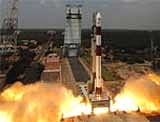

At the end of the 51-hour countdown, under a clear blue sky, the 44.4-metre tall, 230-tonne Indian rocket Polar Satellite Launch Vehicle (PSLV) freed itself from the launch pad at the spaceport, 70 km from Chennai, at 11.51 a.m. and soared upwards with a deep throated growl lugging the 960-kg Oceansat-2 and the six nano satellites all together weighing 20 kg.
In copybook style, the rocket first spat out Oceansat-2 at an altitude of 720 km above the earth in a sun-synchronous orbit (SSO), followed by the four nano satellites - also called Cubesats, each weighing one kg. The remaining two, each weighing eight kg, were attached to the rocket's fourth stage.
The Oceansat2 satellite detached itself from the rocket after 1,081 seconds.
The six nano satellites are owned by European universities - four from Germany and one each from Switzerland and Turkey. They were launched under a commercial agreement.
Soon after the satellites were put into orbit, ISRO's satellite tracking centres started monitoring them.
Scientists cheered as ISRO's workhorse, PSLV soared majestically into clear skies at 11.51 AM from the spaceport in the East Coast in Andhra Pradesh, about 100 km north of Chennai,with the launch watched by Vice President Hamid Ansari.
Oceansat-2, the country's 16th remote sensing satellite, will identify potential fishing zones, sea state forecasting and coastal zone studies, besides providing inputs on weather forecasting and climate studies.
A set of six nano satellites rode piggyback accompanying Oceansat-2 on its trip to orbit.
Ansari and senior scientist M G K Menon, who were present in the mission centre, congratulated ISRO scientists soon after the successful launch.
Besides two German Rubin nano satellites, other Oceansat-2 co-passengers are four cubesats: Beesat, built by Technical University Berlin, UWE-2 (University of Wuerzburg Germany), ITU-pSat(Istanbul Technical University Turkey) and SwissCube-1 (Ecole Polytechnique Federal de Lausanne, Switzerland).
Amid hugs and cheers, Indian Space Research Organisation (ISOR) Chairman G. Madhavan Nair congratulated his scientists and said: "The satellites have been put in their precise orbit."
Designed to last five years, the cuboid shaped Oceansat-2 will study the oceans' interactions with the atmosphere. Oceansat-2 will be used for identifying potential fishing zones, sea-state forecasting, coastal zone studies, weather forecasting and climate studies.
Apart from the ISRO-developed 76 kg Ocean Colour Monitor (OCM) and a Ku-band pencil beam Scatterometer, the satellite will also have a Radio Occultation Sounder for Atmospheric Studies (ROSA) developed by the Italian Space Agency.
The Scatterometer, with a ground resolution of 50 km x 50 km, is expected to provide accurate information on wind speed and direction.
The eight-band OCM, with a 360-metre spatial resolution and a swath of 1,420 km, will provide information about a particular area every two days.
The data will be used by India and will also have a good international market. Bulk of the revenue of Antrix Corporation, the commercial arm of ISRO, is from selling remote sensing data.
With the launch of Oceansat-2, ISRO now has 10 remote-sensing satellites in orbit. The others are IRS 1D, Resourcesat 1, TES, Cartosat 1, 2 and 2A, IMS 1, RISAT and Oceansat-1.
The other remote sensing satellites slated for launch are the Radar Imaging Satellite and Resourcesat-2.